
The Cree are a North American Indigenous people. They live primarily in Canada, where they form one of the country's largest First Nations.
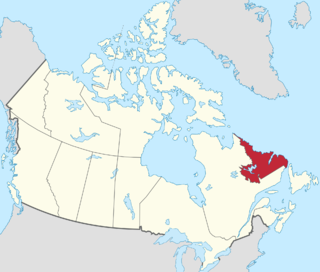
Labrador is a geographic and cultural region within the Canadian province of Newfoundland and Labrador. It is the primarily continental portion of the province and constitutes 71% of the province's area but is home to only 6% of its population. It is separated from the island of Newfoundland by the Strait of Belle Isle. It is the largest and northernmost geographical region in the four Atlantic provinces.

The Innu / Ilnu or Innut / Innuat / Ilnuatsh ("people"), formerly called Montagnais from the French colonial period, are the Indigenous inhabitants of territory in the northeastern portion of the present-day province of Labrador and some portions of Quebec. They refer to their traditional homeland as Nitassinan or Innu-assi.
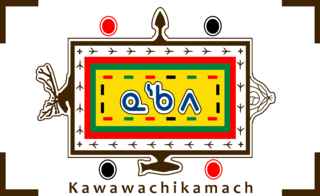
The Naskapi are an Indigenous people of the Subarctic native to the historical country St'aschinuw, which is located in northern Quebec and Labrador, neighbouring Nunavik. They are closely related to Innu Nation, who call their homeland Nitassinan.

Nunatsiavut is an autonomous area claimed by the Inuit in Newfoundland and Labrador, Canada. The settlement area includes territory in Labrador extending to the Quebec border. In 2002, the Labrador Inuit Association submitted a proposal for limited autonomy to the government of Newfoundland and Labrador. The constitution was ratified on December 1, 2005, at which time the Labrador Inuit Association ceased to exist, and the new Government of Nunatsiavut was established, initially being responsible for health, education and cultural affairs. It is also responsible for setting and conducting elections, the first of which was executed in October 2006. An election for the ordinary members of the Nunatsiavut Assembly was held on May 4, 2010. The Nunatsiavut Assembly was dissolved on April 6 in preparation for the election. Its incumbent president is Johannes Lampe who assumed office in 2016.

Labrador is a federal electoral district in Newfoundland and Labrador, Canada, that has been represented in the House of Commons of Canada since 1949.

Nain is the northernmost permanent settlement in the Canadian province of Newfoundland and Labrador, within the Nunatsiavut region, located about 370 km (230 mi) by air from Happy Valley-Goose Bay. The town was established as a Moravian mission in 1771 by Jens Haven and other missionaries. As of 2021, the population is 1,204 mostly Inuit and mixed Inuit-European. Nain is the administrative capital of the autonomous region of Nunatsiavut.
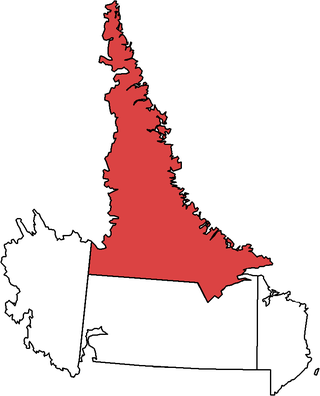
Torngat Mountains is a provincial electoral district for the House of Assembly of Newfoundland and Labrador, Canada. As of 2011 there are 2,130 eligible voters living within the district. The district takes its name from the Torngat Mountains.
The Mushuau Innu First Nation is a First Nations band government located in the province of Newfoundland and Labrador, Canada. The band has one reserve which has been located near the community of Natuashish since 2002 when it moved from Davis Inlet. The reserve has an area of roughly 44 square kilometres.

Sheshatshiu is an Innu federal reserve and designated place in the Canadian province of Newfoundland and Labrador. The reserve is approximately 40 kilometres (25 mi) north of Happy Valley-Goose Bay. Some references may spell the community's name as Sheshatshit, the t spelling is more traditional in the Innu-aimun language, but the u is used more commonly in English to avoid inappropriate connotations. The name means "a narrow place in the river".
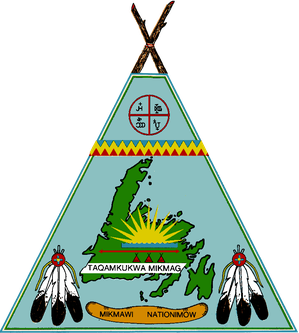
Miawpukek First Nation is a Mi'kmaq First Nations band government in Conne River, Newfoundland and Labrador, Canada, with a registered population of 836 living on-reserve as of May 2023, with another 2,265 living off-reserve. They control the reserve of Samiajij Miawpukek in Bay d'Espoir on the island of Newfoundland. It was formerly known as Conne River Indian Reserve until the mid-1980s. Samiajij Miawpukek was established as a federal Indian reserve in 1987, the first in Newfoundland and Labrador. In 1991, Miawpukek was one of the poorest communities in Atlantic Canada. Due in part to increased education of its members, it has gone on to become the most well-off First Nation in Atlantic Canada after Membertou.
Natuashish is an Innu community in the Canadian province of Newfoundland and Labrador. The community is inhabited by the Mushuau Innu First Nation. Natuashish became a federal Indian reserve in 2003.

Davis Inlet was a Naskapi community in the Canadian province of Newfoundland and Labrador, formerly inhabited by the Mushuau Innu First Nation. It was named for its adjacent fjord, itself named for English explorer, John Davis, who in 1587 charted the region as part of ongoing efforts to find the Northwest Passage to the Pacific.

North West River is a small town located in central Labrador. Established in 1743 as a trading post by French Fur Trader Louis Fornel, the community later went on to become a hub for the Hudson's Bay Company and home to a hospital and school serving the needs of coastal Labrador. North West River is the oldest modern settlement in Labrador.
Aboriginal child protection describes services designed specifically for protection of the children of "aboriginal" or indigenous peoples, particularly where these peoples are a minority within a country. They may differ at international, national, legal, cultural, social, professional and program levels from general or mainstream child protection services. Fundamental human rights are a source of many of the differences. Aboriginal child protection may be an integral or a distinct aspect of mainstream services or it may be exercised formally or informally by an aboriginal people itself. There has been controversy about systemic genocide in child protection systems enforced with aboriginal children in post-colonial societies.
The Muskrat Falls Generating Station is a hydroelectric generating station in the Labrador region of Newfoundland and Labrador, Canada. It comprises part of the remaining 35 per cent of the Churchill River that was not developed by the Churchill Falls Generating Station. The station at Muskrat Falls has a capacity of over 824 MW and provides 4.5 TWh of electricity per year.
Peter Penashue, is a Canadian politician from Newfoundland and Labrador. He was elected as the Conservative Party of Canada Member of Parliament for the riding of Labrador in the 2011 federal election. Penashue was the first Innu from Labrador to be elected to the House of Commons of Canada and the first Innu cabinet minister in Canadian history. He was also the first centre-right MP to be elected from the riding of Labrador since 1968, and only the second ever to win it since Newfoundland and Labrador joined Canada in 1949.
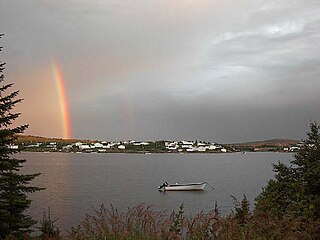
NunatuKavut is an unrecognized Inuit territory in Labrador. The NunatuKavut people claim to be the direct descendants of the Inuit that lived south of the Churchill or Grand River prior to European contact, with recent European admixture primarily from English settlers. Despite claims of Inuit heritage, according to recent censuses completed by Statistics Canada, the vast majority of individuals living in NunatuKavut communities continue to identify as Métis as opposed to 'Inuit'.

Innu Nation of Matimekush-Lac John is a First Nation band government based out of Schefferville, Quebec, Canada. The members of the band are Innu people and speak the Innu language, an Algonquian language which is a member of the Cree–Montagnais–Naskapi dialect continuum.
The Assembly of First Nations Quebec-Labrador (AFNQL) is a political organization representing the First Nations of Quebec and Labrador. It represents these First Nations to the Secrétariat aux affaires autochtones du Québec and to the ministry of Crown-Indigenous Relations and Northern Affairs of Canada. The AFNQL is composed of representatives from 43 communities in the Abenaki, Algonquin, Atikamekw, Cree, Maliseet, Mi'kmaq, Innu, Huron-Wendat and Naskapi nations, as well as from the Mohawks. The AFNQL does not represent the Inuit or any Inuit community; they are represented by Inuit Tapiriit Kanatami.















